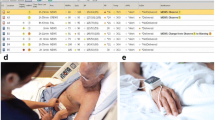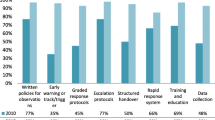Abstract
Objective
Most centres in Europe have not introduced a rapid response team (RRT), partly because of concerns that data from other health-care systems may not be relevant. We tested whether patient characteristics and outcomes for deteriorating patients differ between two health-care systems separated by distance and culture.
Methods
We obtained data from 3,063 RRT calls: 815 calls at Karolinska University Hospital (Sweden) and 2,248 calls at Austin Hospital (Australia) and compared demographic and clinical data, as well as outcomes for patients reviewed by a RRT.
Results
At Karolinska, 46.9% of patients were female compared with 45.1% at Austin. Mean age was 66.5 years versus 69.4 years. The unit of admission was surgical/medical in 49.1%/50.9% versus 48.8%/51.1% of patients, respectively. Overall, 56.7% versus 55.8% of the calls were out-of-hours (1700–0800 hours). There was a predominance of respiratory triggers at both centres and the “worried” criterion was frequently used in both hospitals (17.2% versus 14.4%) as a trigger for RRT activation. Overall, 30-day mortality was 27.7% versus 29.4% and allocation of Limitations of Medical Treatment (LOMT) orders was 34.2% versus 30.8%. The allocation of LOMT orders was influenced by the RRT in 14.4% versus 12.6% of cases.
Conclusion
In two different health-care systems separated by geography, language, culture and organizational features, the characteristics of deteriorating ward patients, their disposal and outcomes were similar, suggesting that the care of the deteriorating ward patient is a global problem in modern hospitals and confirming that their hospital mortality is high.
Similar content being viewed by others
References
Brennan TA, Leape LL, Laird NM, Hebert L, Localio AR, Lawthers AG, Newhouse JP, Weiler PC, Hiatt HH (1991) Incidence of adverse events and negligence in hospitalized patients. Results of the Harvard Medical Practice Study I. N Engl J Med 324:370–376
Leape LL, Brennan TA, Laird N, Lawthers AG, Localio AR, Barnes BA, Hebert L, Newhouse JP, Weiler PC, Hiatt H (1991) The nature of adverse events in hospitalized patients. Results of the Harvard Medical Practice Study II. N Engl J Med 324:377–384
Chan PS, Jain R, Nallmothu BK, Berg RA, Sasson C (2010) Rapid response teams: a systematic review and meta-analysis. Arch Intern Med 170:18–26
Hillman KM, Bristow PJ, Chey T, Daffurn K, Jacques T, Norman SL, Bishop GF, Simmons G (2001) Antecedents to hospital deaths. Intern Med J 31:343–348
Kause J, Smith G, Prytherch D, Parr M, Flabouris A, Hillman K (2004) A comparison of antecedents to cardiac arrests, deaths and emergency intensive care admissions in Australia and New Zealand, and the United Kingdom – the ACADEMIA study. Resuscitation 62:275–282
Devita MA, Bellomo R, Hillman K, Kellum J, Rotondi A, Teres D, Auerbach A, Chen WJ, Duncan K, Kenward G, Bell M, Buist M, Chen J, Bion J, Kirby A, Lighthall G, Ovreveit J, Braithwaite RS, Gosbee J, Milbrandt E, Peberdy M, Savitz L, Young L, Harvey M, Galhotra S (2006) Findings of the first consensus conference on medical emergency teams. Crit Care Med 34:2463–2478
Buist MD, Moore GE, Bernard SA, Waxman BP, Anderson JN, Nguyen TV (2002) Effects of a medical emergency team on reduction of incidence of and mortality from unexpected cardiac arrests in hospital: preliminary study. BMJ 324:387–390
Bellomo R, Goldsmith D, Uchino S, Buckmaster J, Hart GK, Opdam H, Silvester W, Doolan L, Gutteridge G (2003) A prospective before-and-after trial of a medical emergency team. Med J Aust 179:283–287
DeVita MA, Braithwaite RS, Mahidhara R, Stuart S, Foraida M, Simmons RL (2004) Use of medical emergency team responses to reduce hospital cardiopulmonary arrests. Qual Saf Health Care 13:251–254
Baxter AD, Cardinal P, Hooper J, Patel R (2008) Medical emergency teams at The Ottawa Hospital: the first two years. Can J Anaesth 55:223–231
Konrad D, Jaderling G, Bell M, Granath F, Ekbom A, Martling CR (2010) Reducing in-hospital cardiac arrests and hospital mortality by introducing a medical emergency team. Intensive Care Med 36:100–106
Delaney A, Angus DC, Bellomo R, Cameron P, Cooper DJ, Finfer S, Harrison DA, Huang DT, Myburgh JA, Peake SL, Reade MC, Webb SA, Yealy DM (2008) Bench-to-bedside review: the evaluation of complex interventions in critical care. Crit Care 12:210
Hillman K, Chen J, May E (2009) Complex intensive care unit interventions. Crit Care Med 37:S102–S106
Winters BD, Pham JC, Hunt EA, Guallar E, Berenholtz S, Pronovost PJ (2007) Rapid response systems: a systematic review. Crit Care Med 35:1238–1243
Hillman K, Chen J, Cretikos M, Bellomo R, Brown D, Doig G, Finfer S, Flabouris A (2005) Introduction of the medical emergency team (MET) system: a cluster-randomised controlled trial. Lancet 365:2091–2097
Chen J, Bellomo R, Flabouris A, Hillman K, Finfer S (2009) The relationship between early emergency team calls and serious adverse events. Crit Care Med 37:148–153
Priestley G, Watson W, Rashidian A, Mozley C, Russell D, Wilson J, Cope J, Hart D, Kay D, Cowley K, Pateraki J (2004) Introducing critical care outreach: a ward-randomised trial of phased introduction in a general hospital. Intensive Care Med 30:1398–1404
Cretikos M, Parr M, Hillman K, Bishop G, Brown D, Daffurn K, Dinh H, Francis N, Heath T, Hill G, Murphy J, Sanchez D, Santiano N, Young L (2006) Guidelines for the uniform reporting of data for medical emergency teams. Resuscitation 68:11–25
Schein RM, Hazday N, Pena M, Ruben BH, Sprung CL (1990) Clinical antecedents to in-hospital cardiopulmonary arrest. Chest 98:1388–1392
Bell MB, Konrad D, Granath F, Ekbom A, Martling CR (2006) Prevalence and sensitivity of MET-criteria in a Scandinavian University Hospital. Resuscitation 70:66–73
Lighthall GK, Markar S, Hsiung R (2009) Abnormal vital signs are associated with an increased risk for critical events in US veteran inpatients. Resuscitation 80:1264–1269
Jones D, Bellomo R, Bates S, Warrillow S, Goldsmith D, Hart G, Opdam H, Gutteridge G (2005) Long term effect of a medical emergency team on cardiac arrests in a teaching hospital. Crit Care 9:R808–R815
Dacey MJ, Mirza ER, Wilcox V, Doherty M, Mello J, Boyer A, Gates J, Brothers T, Baute R (2007) The effect of a rapid response team on major clinical outcome measures in a community hospital. Crit Care Med 35:2076–2082
Kenward G, Castle N, Hodgetts T, Shaikh L (2004) Evaluation of a medical emergency team one year after implementation. Resuscitation 61:257–263
Casamento AJ, Dunlop C, Jones DA, Duke G (2008) Improving the documentation of medical emergency team reviews. Crit Care Resusc 10:29
Jones DA, McIntyre T, Baldwin I, Mercer I, Kattula A, Bellomo R (2007) The medical emergency team and end-of-life care: a pilot study. Crit Care Resusc 9:151–156
Cretikos MA, Chen J, Hillman KM, Bellomo R, Finfer SR, Flabouris A (2007) The effectiveness of implementation of the medical emergency team (MET) system and factors associated with use during the MERIT study. Crit Care Resusc 9:206–212
Author information
Authors and Affiliations
Corresponding author
Electronic supplementary material
Below is the link to the electronic supplementary material.
Rights and permissions
About this article
Cite this article
Jäderling, G., Calzavacca, P., Bell, M. et al. The deteriorating ward patient: a Swedish–Australian comparison. Intensive Care Med 37, 1000–1005 (2011). https://doi.org/10.1007/s00134-011-2156-x
Received:
Accepted:
Published:
Issue Date:
DOI: https://doi.org/10.1007/s00134-011-2156-x




